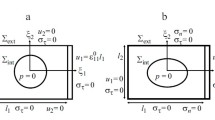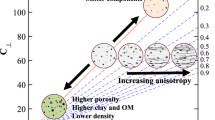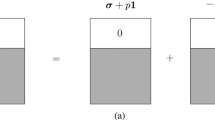Abstract
Several experimental studies, carried out on anisotropic rocks, have evidenced that even though strains, due to isotropic loading and/or internal fluid pressure, are strongly anisotropic, the resulting Biot’s tensor is almost isotropic. Those results were found on two different rocks: a clay rock (France—Bure argillite) and a sandstone from the Vosges region (France). Such (a priori) surprising results led us to develop micromechanical modelling in which anisotropy comes either from an anisotropic solid matrix (and isotropic pore space) or from an anisotropic pore space (and isotropic solid matrix). The obtained results have shown that for both cases the Biot’s tensor is virtually isotropic or presents a very weak anisotropy. This unambiguously supports the fact that a strongly anisotropic porous material is compatible with experimental measurements of isotropic (or quasi isotropic) Biot’s tensor.









Similar content being viewed by others
Abbreviations
- \({\varvec{\sigma }}\) :
-
Cauchy stress tensor
- \({\varvec{\epsilon }}\) :
-
Infinitesimal strain tensor
- \(\gamma \) :
-
Infinitesimal distortion strain
- E :
-
Young’s modulus
- \(\nu \) :
-
Poisson coefficient
- b :
-
Biot’s coefficient (scalar)
- \({\varvec{B}}\) :
-
Biot’s coefficient (tensorial)
- H :
-
Expansion modulus
- \(P_c\) :
-
Confining pressure
- p :
-
Pore pressure
- \(\mathbb {C}\) :
-
Fourth-rank stiffness tensor
- \(\mathbb {C}^{dr}\) :
-
Fourth-rank drained stiffness tensor
- \({\varvec{\delta }}\) :
-
Second-rank identity tensor
- \(\mathbb {I}\) :
-
Symmetrized fourth-rank identity tensor
- \(\mathbb {A}\) :
-
Fourth-rank strain concentration tensor
- X :
-
Spheroidal inclusion aspect ratio
- \(\mathbb {P}(X)\) :
-
Fourth-rank Hill tensor of a spheroidal inclusion
References
Biot M (1955) Theory of elasticity and consolidation for a porous anisotropic solid. J Appl Phys 26(2):182–185
Cheng AD (1997) Material coefficient of anisotropic poroelasticity. Int J Rock Mech Min Sci 34(2):199–205
Dormieux L, Ulm FJ, Kondo D (2006) Microporomechanics. Wiley, New York
Hu C, Agostini F, Skoczylas F, Jeannin L, Potier L (2018) Poromechanical properties of a sandstone under different stress. Rock Mech Rock Eng 51:120–132. https://doi.org/10.1007/s00603-018-1550-x
Mohajerani M, Delage P, Monfared M, Tang A, Sulem J, Gatmiri B (2011) Oedometric compression and swelling behaviour of the Callovo–Oxfordian argillite. Int J Rock Mech Min Sci 48(4):606–615
Song Y, Davy C, Troadec D, Blanchenet A, Skoczylas F, Talandier J, Robinet J (2015) Multi-scale pore structure of cox claystone: towards the prediction of fluid transport. Mar Pet Geol 65:63–82
Suarez-Rivera R, Fjær E (2013) Evaluating the poroelastic effect on anisotropic, organic rich, mudstone systems. Rock Mech Rock Eng 46:569–580
Wong TF (2017) Anisotropic poroelasticity in a rock with cracks. J Geophys Res Solid Earth 122:7739–7753
Yang D, Bornert M, Chanchole S, Gharbi H, Valli P, Gatmiri B (2012) Dependence of elastic properties of argillaceous rocks on moisture content investigated with optical full-field strain measurement techniques. Int J Rock Mech Min Sci 53:45–55
Yuan H, Agostini F, Duan Z, Skoczylas F, Talandier J (2018) Measurement of biot’s coefficient for cox argillite using gas pressure technique. Int J Rock Mech Min Sci Geomech Abstr 92:72–80
Author information
Authors and Affiliations
Corresponding author
Ethics declarations
Conflict of interest
The authors declare that they have no conflict of interest.
Additional information
Publisher's Note
Springer Nature remains neutral with regard to jurisdictional claims in published maps and institutional affiliations.
Appendix: Hill Tensor of an Ellipsoid
Appendix: Hill Tensor of an Ellipsoid
Consider an ellipsoid defined by the equation:
where \({\varvec{S}}\) is a positive definite symmetric second-rank tensor. This ellipsoid is embedded in an infinite linear elastic medium with elastic stiffness tensor \(\mathbb {C}\). Let \({\varvec{\xi }}\) denote some vector on the unit sphere: \(|{\varvec{\xi }}|=1\). The associated acoustic tensor is \({\varvec{K}}={\varvec{\xi }}\cdot \mathbb {C}\cdot {\varvec{\xi }}\). The coefficient \(P_{ijkl}\) of the Hill tensor reads:
In the above expression, the integral is taken with respect to \({\varvec{\xi }}\) over the unit sphere. The subscript \((ij),(k\ell )\) means that the expression is symmetrized w.r.t. the subscripts i and j, and w.r.t. the subscripts k and \(\ell \):
In Sect. 3.1.2, the Hill tensor \(\mathbb {P}^m(\theta ,\phi ,X)\) refers to a spheroid with aspect ratio X, and a symmetry axis along the radial unit vector \({\varvec{e}}_r(\theta ,\phi )\):
It is recalled that the matrix is transversely isotropic (symmetry axis along \({\varvec{e}}_3\)). In the spherical basis \(({\varvec{e}}_r,{\varvec{e}}_\theta ,{\varvec{e}}_\phi )\), the tensor \({\varvec{S}}(\theta ,\phi ,X)\) of this spheroid reads:
The integration variables in (11) are the two angles x and y that define the unit vector \({\varvec{\xi }}\):
where \({\text {d}}S_\xi =\sin x\,{\text {d}}x{\text {d}}y\).
Rights and permissions
About this article
Cite this article
Hu, C., Lemarchand, E., Dormieux, L. et al. Quasi-isotropic Biot’s Tensor for Anisotropic Porous Rocks: Experiments and Micromechanical Modelling. Rock Mech Rock Eng 53, 4031–4041 (2020). https://doi.org/10.1007/s00603-020-02147-7
Received:
Accepted:
Published:
Issue Date:
DOI: https://doi.org/10.1007/s00603-020-02147-7




